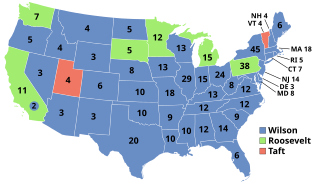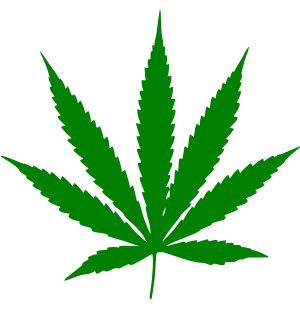
The United States presidential election of 1912 was the 32nd quadrennial presidential election, held on Tuesday, November 5, 1912. Democratic Governor Woodrow Wilson of New Jersey unseated incumbent Republican President William Howard Taft and defeated former President Theodore Roosevelt, who ran as the Progressive Party nominee. Roosevelt remains the only third party presidential candidate in U.S. history to finish better than third in the popular or electoral vote.

Third party is a term used in the United States for American political parties other than the Republican and Democratic parties.

The Grassroots-Legalize Cannabis Party is a political third party in the U.S. state of Minnesota created in 1986 to oppose drug prohibition. The party shares many of the progressive values of the Farmer-Labor Party but with an emphasis on cannabis/hemp legalization issues.

In United States presidential elections, a faithless elector is a member of the United States Electoral College who does not vote for the presidential or vice presidential candidate for whom they had pledged to vote. That is, they break faith with the candidate they were pledged to and vote for another candidate, or fail to vote. A pledged elector is only considered a faithless elector by breaking their pledge; unpledged electors have no pledge to break.

The 2002 Minnesota gubernatorial election took place on November 5, 2002 for the post of Governor of Minnesota. Republican candidate Tim Pawlenty defeated Democratic candidate Roger Moe and Independence Party of Minnesota candidate Tim Penny. Due to a state economy in recession and underwater approval ratings, Incumbent Independence Party Governor Jesse Ventura chose not to seek reelection.

The 1912 Minnesota gubernatorial election took place on November 5, 1912. Republican Party of Minnesota candidate Adolph Olson Eberhart defeated Democratic Party of Minnesota challenger Peter M. Ringdahl.

The Independence Party of Minnesota, formerly the Reform Party of Minnesota, is a political party in the U.S. state of Minnesota. It was the party of former Minnesota Governor Jesse Ventura (1999–2003).

The Socialist Party of Minnesota was the state affiliate of the Springfield faction of the Social Democratic Party of America, the Socialist Party of America, and finally the Socialist Party USA in the U.S. state of Minnesota.

A general election was held in the U.S. state of Minnesota on November 4, 2014. All of Minnesota's executive officers were up for election as well as all the seats in the Minnesota House of Representatives, several state judicial seats, a United States Senate seat, all of Minnesota's eight seats in the United States House of Representatives, and several seats for local offices. A primary election was held on August 12, 2014, to nominate major political party candidates for partisan offices and candidates for nonpartisan offices.

Legal Marijuana Now is a political third party in the United States established in 1998 to oppose drug prohibition. The party shares many of the progressive values of the Farmer-Labor Party but with an emphasis on marijuana/hemp legalization issues.

The 2018 United States Senate election in Minnesota took place on November 6, 2018, to elect a United States Senator from Minnesota. Democratic incumbent Amy Klobuchar was easily reelected to a third term in office. This election was held alongside a special election for Minnesota's other Senate seat, which was held by Al Franken until he resigned in January 2018. U.S. House elections, a gubernatorial election, State House elections, and other elections were also held.

Following is a table of United States presidential elections in Minnesota, ordered by year. Since its admission to statehood in 1858, Minnesota has participated in every U.S. presidential election.

The 1932 United States presidential election in Minnesota took place on November 8, 1932, in Minnesota as part of the 1932 United States presidential election.

The 1912 United States presidential election in Minnesota took place on November 5, 1912, in Minnesota as part of the 1912 United States presidential election.

The 1920 Minnesota lieutenant gubernatorial election took place on November 2, 1920. Republican Party of Minnesota candidate Louis L. Collins defeated Independent challenger George H. Mallon and Minnesota Democratic Party candidate James P. McDonnell.

The 1916 Minnesota lieutenant gubernatorial election took place on November 7, 1916. Republican Party of Minnesota candidate Thomas Frankson defeated Minnesota Democratic Party challenger Julius Thorson, Socialist Party of Minnesota candidate Andrew Hanson, and Prohibition Party candidate L. A. Simonson.

A general election was held in the U.S. state of Minnesota on November 6, 2018. All of Minnesota's executive officers were up for election as well as all the seats in the Minnesota House of Representatives, several judicial seats, a United States Senate seat, Minnesota's eight seats in the United States House of Representatives, and several seats for local offices. Special elections were also be held for a Minnesota Senate seat and Minnesota's Class 2 U.S. Senate seat. A primary election to nominate Republican and Democratic–Farmer–Labor (DFL) candidates and several judicial and local primary elections were held on August 14, 2018.

The 1912 United States presidential election in Maine took place on November 5, 1912, as part of the 1912 United States presidential election which was held throughout all contemporary 48 states. Voters chose six representatives, or electors to the Electoral College, who voted for president and vice president.




















